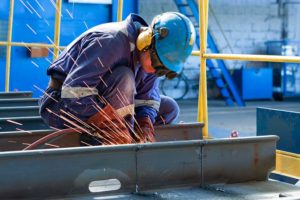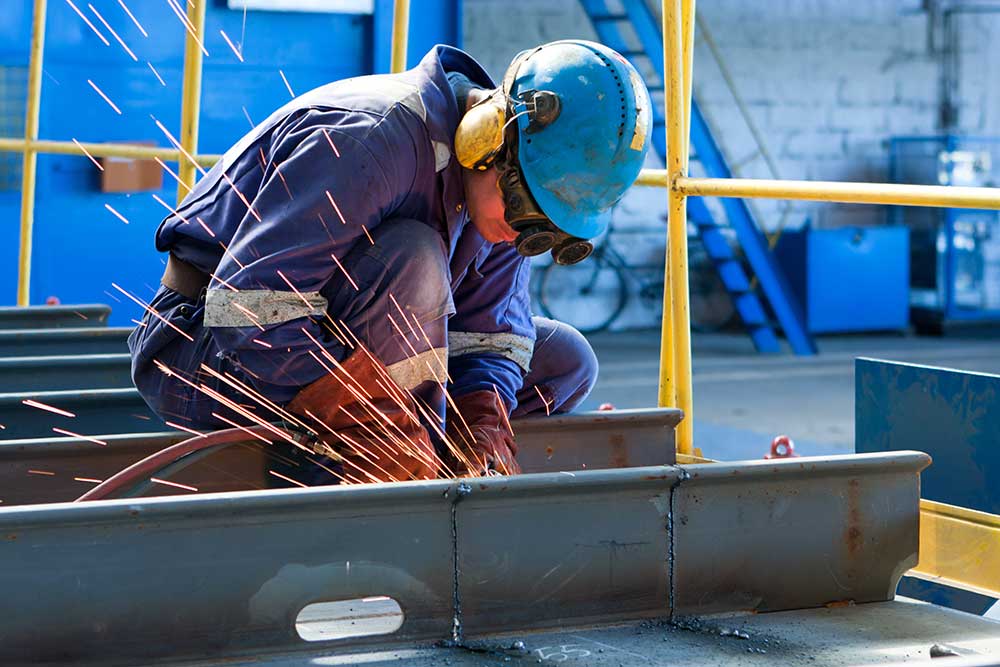Disclaimer: The information on our website is provided for general information purposes only. We make no representations or warranties of any kind, express or implied, about the completeness, accuracy, reliability, suitability or availability with respect to the website or the information contained on our website for any purpose. Any reliance on such information is therefore strictly at your own risk and we are not liable for any damages or losses arising out of or resulting from your reliance on any information contained on our website.
A structural metal fabricator works with large metal pieces to create a metal structural product that will often be used in a construction project, including buildings and other structures such as bridges. These workers may use a variety of hand, power, and hydraulic lift tools.
Watch a video to learn what a structural metal fabricator does:
How to Become a Structural Metal Fabricator
According to O*NET OnLine, almost 50% of all structural metal fabricators have a high school diploma. Over 45% have a post-secondary certification or some college. Certificates can be earned through vocational schools or even as associations that are affiliated with the industry. One association that offers certifications is the Fabricators & Manufacturers Association International (FMA). They offer a Precision Sheet Metal Operator Certification (PSMO) and the Precision Press Brake Certification (PPB). There is also the AISC Certification through the American Institute of Steel Construction for fabricators and erectors.
Vocational schools and community colleges also offer welding classes or fabrication programs. To find out more, go to your local educational facilities to see what they offer. These programs usually focus on fabrication techniques, welding, cutting, safety, equipment use, and reading blueprints.
Remember, these are not required; however, it can be helpful when applying for a job. You may be able to gain an entry-level position as a helper with a high school diploma or equivalent while you gain on-the-job experience that may lead to other opportunities down the road.
Job Description of a Structural Metal Fabricator
A structural metal worker primary job is to fabricate metal structures. They read and follow blueprints to study specifications to fabricate large metal objects for its structural purpose. Structural metal fabricators must align, fit, and weld parts to form complete units or subunits using the correct specifications. They often weld, use hand tools, and hydraulic lifts to accomplish their day-to-day tasks. Other tools include jacks, turnbuckles, wedges, pry bars, and hammers.
Structural metal fabricators must also have skills and knowledge in computer-aided design CAD software, mechanical knowledge of machines and tools, mathematics abilities, building and construction skills, and the ability to read or draw blueprint designs.
Job sites are usually outside, and many structural metal fabricators work full time for contractors or manufacturing plants. This job can be very physical, requiring heavy lifting and standing for prolonged periods. Some positions also require them to climb or squat to access areas that may be tight or hard to access spots. Their work environment may be noisy, dusty, and prone to injuries such as cuts, burns, or falls. To reduce accidents, structural metal fabricators should wear face masks, safety glasses, and ear protection.
Structural Metal Fabricators Career Video Transcript

Some manufacturing workers like their jobs super-sized. Structural metal fabricators and fitters construct enormous metal objects, from tanks and water towers, to frames for buildings and bridges. Though the projects can be massive, the work is quite precise. Following blueprints or drawings, they develop patterns to build metal parts. They use a broad array of hand, electric, and hydraulic tools to align and fit parts to specifications. They use special machinery to cut the metal into the required pieces or plates. Other equipment is used to punch, roll, or straighten the pieces before they are fastened together.
After determining the sequence of tasks needed to fit all the parts together, they weld, bolt, or rivet the units to assemble parts into a whole. They may operate hoists or cranes to move large parts. Fabricators and fitters often work indoors in huge, noisy environments. Installation at outdoor construction sites may require work in extreme temperatures. Some jobs may also require being away from home for long periods of time. A high school diploma usually meets the requirements to get a job as a helper, or to enter a training program or apprenticeship for this career.
Math, construction, and mechanical knowledge are a foundation in this field. You need to be in good physical condition to handle the heavy lifting and climbing this career demands. Many tasks are performed high up on scaffolds or in cramped spaces. Fabricators and fitters need to be able to use their tools and machines steadily and surely at any height. Protective gear is usually required. Metal is a versatile, durable material that can be bent and formed into just about any shape. Fabricators and fitters have the satisfaction of knowing that what they create today will still be in use for generations.
Article Citations
Bureau of Labor Statistics, U.S. Department of Labor, Occupational Outlook Handbook, Structural Metal Fabricators.
National Center for O*NET Development. 51-2041.00. O*NET OnLine.

